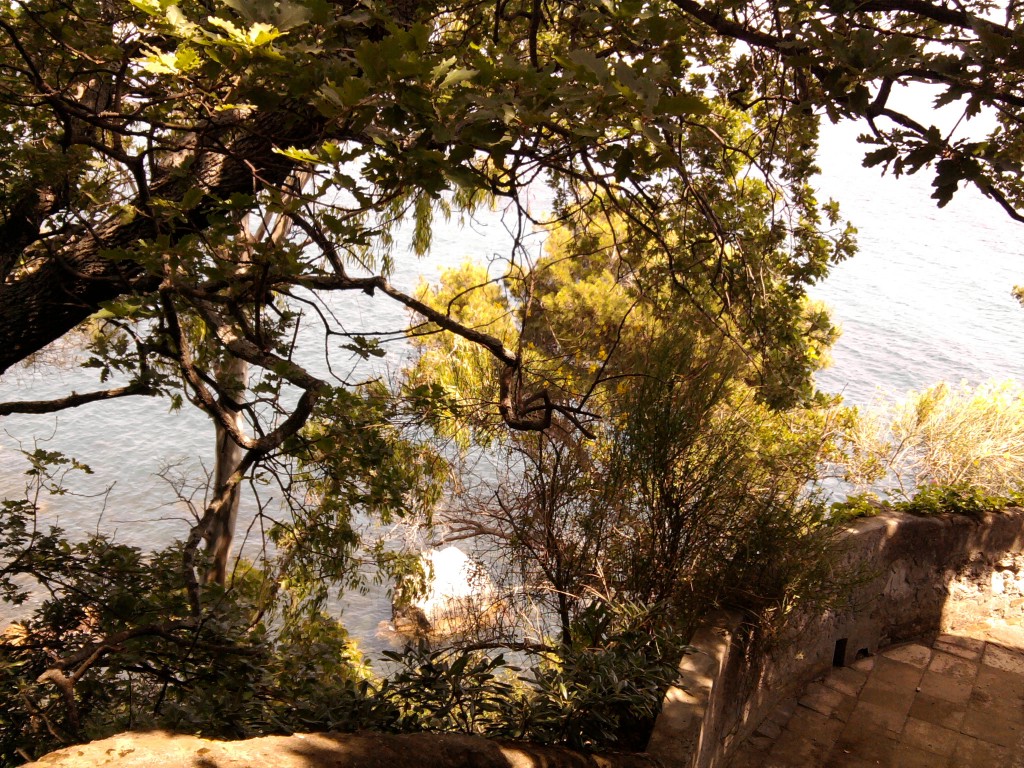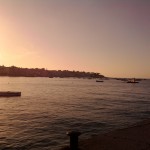Weather forecasts are not good starting from tomorrow. Come on…we need just few more shots!!!
Fingers crossed…

We moved to the Northern area today. The southern site was hit by a strong southern wind and it was very difficult to work with the tripod falling continuously. The northern area was more accessible. Here too there is an acidified area and a less acidified one next to it. The scenario is always astonishing.
We used the same methodology: we anchored, waited until the current stabilised the rib and placde the tripod few meter away from the rib. The video recordings though were quite disappointing in this location. The area appeared less inhabited. It was only at the end of the day that something changed: the temperature has raised quite a lot and Nico could not stay on board anymore. So, he jumped in the water with the mask on and soon after few meters he raised his head yelling:”it’s full of fish here!!!”. And there they were, all hanging out around my tripod, away from our sight.
We realised soon that our methodology needed to be slightly modified. We wanted to use the fixed camera to video the feeding activity of Sarpa salpa, but they are highly motile and it is quite difficult to capture them. We decided, therefore, to point the bullet camera on the tripod in an area where there was high passage of fish, and to follow the feeding activity of this species by using the gopro camera. We went back to the diving center, we rented 2 wetsuits and all the equipment to snorkel, ready to dive and video the animals moving. This has been the key finding of the entire study. We understood that the methodology used so far works well in cold places where we are used to work, but here the sea temperature allows us to dive and therefore, to follow the animals. It was a relief. Now we are ready to start the playbacks.
We mounted the gopro camera on a “highly tech” support kindly offered by the landlady, Lina, and we tested its deployment on the next Saturday…it worked!!!
It has been a busy week so far. The island was very crowded and lots of taxi boats have been moving back and forth through the bay. The acoustic recordings will shown this increased level of underwater noise I am sure. We experienced quite few difficulties in finding the control area to compare to the acidified one. The area originally spotted as control is now not accessible because they found a roman city underwater and they are digging to reveal it. For this reason, we explored different other areas but none of them were comparable. We acoustically survey the bay, though, and this is a good achievement.
It was also difficult to work with the strong wind that blew now and then during the day, but we learnt how it changes and we scheduled the rest of the week according to its strength and direction.
Nico was brave enough to jump in the water that it is still very cold. The “scogli di Sant Anna” could be a good spot, although the taxi boats are omnipresent here and the seabed is too deep for placing the tripod. We captured few other videos of fish from the southern area and we understood better their daily movements.
As scheduled, on Monday, Nico and I went to Casamicciola to take the rental rib and sailed to Ischia Ponte where the area study is. Over the weekend, we arranged with the Ischia diving center to get a small cart to move our heavy things. We also found a small storage next to the peer where to keep all our equipment. This way we should be able to save time in the morning and be able to start to work early. We decided to work in the Southern area of the castello during the first 3 days and then move to North.
It is still quite cold here and the water temperature doesn’t invite to dive.
We took all morning to assemble and transfer all the equipment to the boat, but at lunch time we were able to deploy the tripod. The point of interest was shown by Maria Cristina that was diving that morning for her study. The white signal on the cliff indicated the acidified area. Underwater this area is revealed by gas bubbles coming from the sea floor.
The very first shots we took gave us great enthusiasm. The area is inhabited by several species: damselfish are the most curious…they come close to the camera, maybe attracted by the light. See: Underwater video of Southern area.
There are also several species of seabream, anchovy and mullets and of course the salema porgy feeding on posidonia. See: Underwater video of Southern area 2.
We had a slightly frustrating first week of work because one of the participants (we are 2 people in total !) to this project was ill. It seemed that the heavy rain and the humid weather found at our arrival in Italy has knocked him down. The week was therefore spent by exploring the study areas from the shore and familiarising with the local resources, but no field work was possible. The castello Aragonese seems quite accessible for the study during the early hours of the day when relatively few boats are present in the bay. Walking on the bridge that reaches the castello, the Northern area has a small shore made of rocks from where it is possible to reach the sea, which doesn’t go beyond a depth of 3 to 4 mt. The Southern area, can be reached only using the boat because the shore is quite distant. This area is the busiest. Until 11:00 the bay is quite calm, while after that time until 14:00 several taxi boats and small crafts (4-6 mt long) crowd the bay. The taxi boat service serves the local restaurants located in the southern area of the bay, bringing people back and forth and therefore. They use small wooden boats with a 8 HP engine. The maritime traffic slows after 17:00, although after then, it is possible to meet lots of people bathing in the area and performing divings from the adjacent cliff. The Northern area is generally less populated by taxi boats, but when the weather is good, bigger boats come to anchor in this area. This is very variable as this area is hit by strong Western wind after 14:00 and this can last until 18:00 or even longer (23:00). Local people call this wind as “maestrale fresco (fresh Northwest wind)” because it brings the good weather. Personally, it is a strong wind that creates high waves and can make the work very hard to perform, but I am not the best sailor!
I went to meet Raffaele that rented us the rib, a 6.8mt vessel with a 40HP engine. It is located 4km away from the study area and for this reason I negotiated to keep it moored in the local bay next to the castello to avoid going back and forth every day.
At the end of the first week, my valuable collaborator, Nico, has recovered and we took the rib on Saturday to explore the areas and, overall, to practice with the rib. We are now ready to start the survey first thing on Monday!
Ciao.
Ilaria
Very productive day today. We met Maria Cristina Gambi at the hosting lab and we discussed the logistics to perform the study in the safest and most efficient way. The location where the Lab is, in addition to be immersed in a wild evergreen vegetation similar to a paradise, offers easy access to the sea and it is not far from the area study. 
We spent the afternoon assembling the video and audio system. Everything worked properly after few testings and we look forward to sail the sea!
Ciao for now,
Ilaria

This gallery contains 2 photos.
We arrived to Ischia on Sunday. It was holiday here and the streets were full of people that were enjoying the warm sun. The place where we stay is amazing and the view is astonishing.
The Ischia project was thought to perform my PhD study on the effects of underwater noise on fish behaviour. Ischia is a volcanic island in the Southern Mediterranean sea. It is located in front of the Naples harbour and next to the most famous Capri island in Italy.
The reason why I decided to move the field work to Ischia was that the underwater visibility is excellent here and it will allow me to film the behavioural reaction of fish to playback underwater noise. In addition to this, Ischia has natural CO2 vents that makes the seawater naturally acidified. What I would like to investigate is whether or not the behavioural response to playback noise will be different in condition of CO2 enriched seawater compared to the normal one.
The target species, Sarpa salpa (Teleostei: Sparidae), inhabits both areas, with acidified and normal seawater, grazing on the edge of Posidonia oceanica meadows, endemic of the Mediterranean Sea. Sarpa salpa, known commonly as the Salema porgy, is a species of bream, recognisable by the golden stripes that run down the length of its body. This species is ecologically significant in the Posidonia oceanica seagrass meadows as it accounts for up to 75% of the total herbivorous consumption and represents a significant part of the fish fauna.
I will use a video system made of an underwater camera connected to a HD digital recorder placed on a custom-built tripod, which will be employed from the rib, to video the behavioural response of groups of salema feeding on seagrass meadows. The target behavioural response will be therefore a biologically important one, which, if affected by noise exposure, might lead to important ecological consequences in terms of fitness of this species and the role that this species has as consumer of primary production.
The acoustic system includes 2 loudspeakers connected to an amplifier that will playback man-made noise at different levels. Attached to the tripod there will be also a calibrated hydrophone, which will be used during the initial survey to record the background level of noise to which this species is exposed and later on to record the playback noise levels of the playback signal. I intend to use both playback of sound from a ferry boat and a smaller vessel.
The first week of study will be used to survey the 2 areas and create the behavioural baseline. The following weeks will be dedicated to the playback experiments.
Wish me good luck!